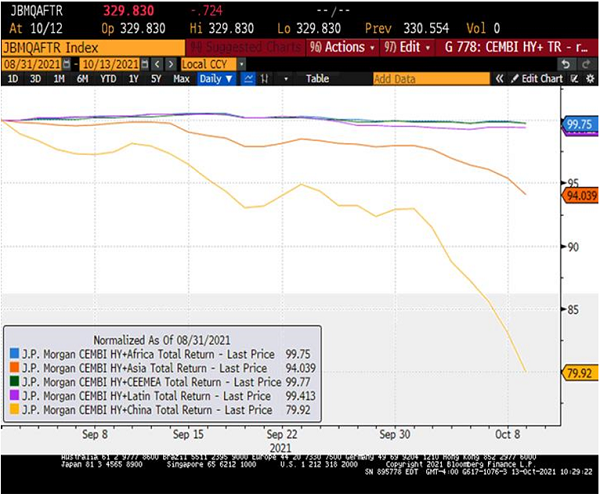IMF meetings – identifying key risks
We are at the IMF annual meetings this week, and participants are figuring out the path forward for growth and inflation. Developed markets growth has been hit by inflationary supply constraints. Is this temporary? Emerging markets (EM) have been hit by the pandemic amid rising food and energy prices. Is this temporary? What about social “scarring” in EM, it may be temporary, or last for years, potentially affecting fiscal/debt trajectories and the interest rate burden, There are also tail risks, particularly from China. Will expected policy support in China be enough to mitigate them? We are still digesting the meetings but we will provide our takeaways shortly.
In regards to China’s tail risks, the chart below shows that broader market spillovers from the property sector seem to be contained for now, even in high yield. The property sector however is having a bigger impact on China’s domestic indicators, including credit expansion—both new loans and total social financing surprised to the downside in September. At the same time, net government bond issuance remained strong, and both household and corporate lending showed sequential improvement. These details suggest that China’s credit growth may be bottoming out, which we believe should be growth-positive going forward.
The world economy is going through an unprecedented period, but we are hearing a lot of superlatives about the growth rebound in many EMs, their vaccination progress, very solid external balances, and much-improved policy frameworks. The latter means that EMs now have more tools at their disposal to react to shocks in an orthodox manner, without depleting their reserves and creating balance of payment crises. The deepening of EM domestic markets improves the transmission mechanism, so changes in policy rates have a more meaningful impact on the real economy. These are some of the reasons why more EMs are now becoming eligible for benchmark index inclusions, such as J.P. Morgan’s local government bond index (GBI-EM). We learned today that Egypt will be included in the index in January 2022, Ukraine will join in March 2022, and India will be placed on Index Watch for GBI-EM eligibility – this is a huge off-index market, so warrants attention.
Chart at a glance: Market spillovers from China property sector seem contained

Source: Bloomberg LP
Published: 13 October 2021




